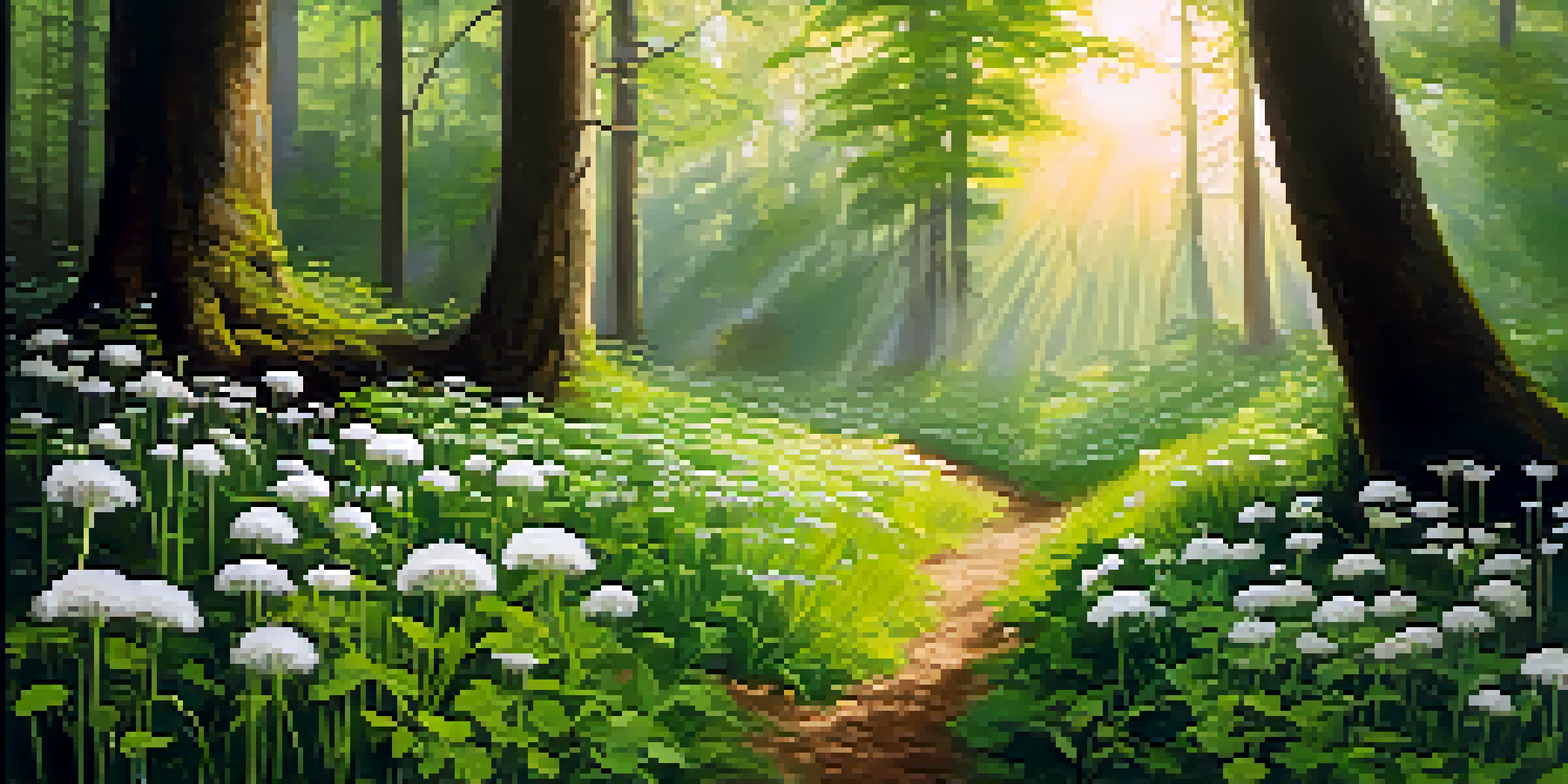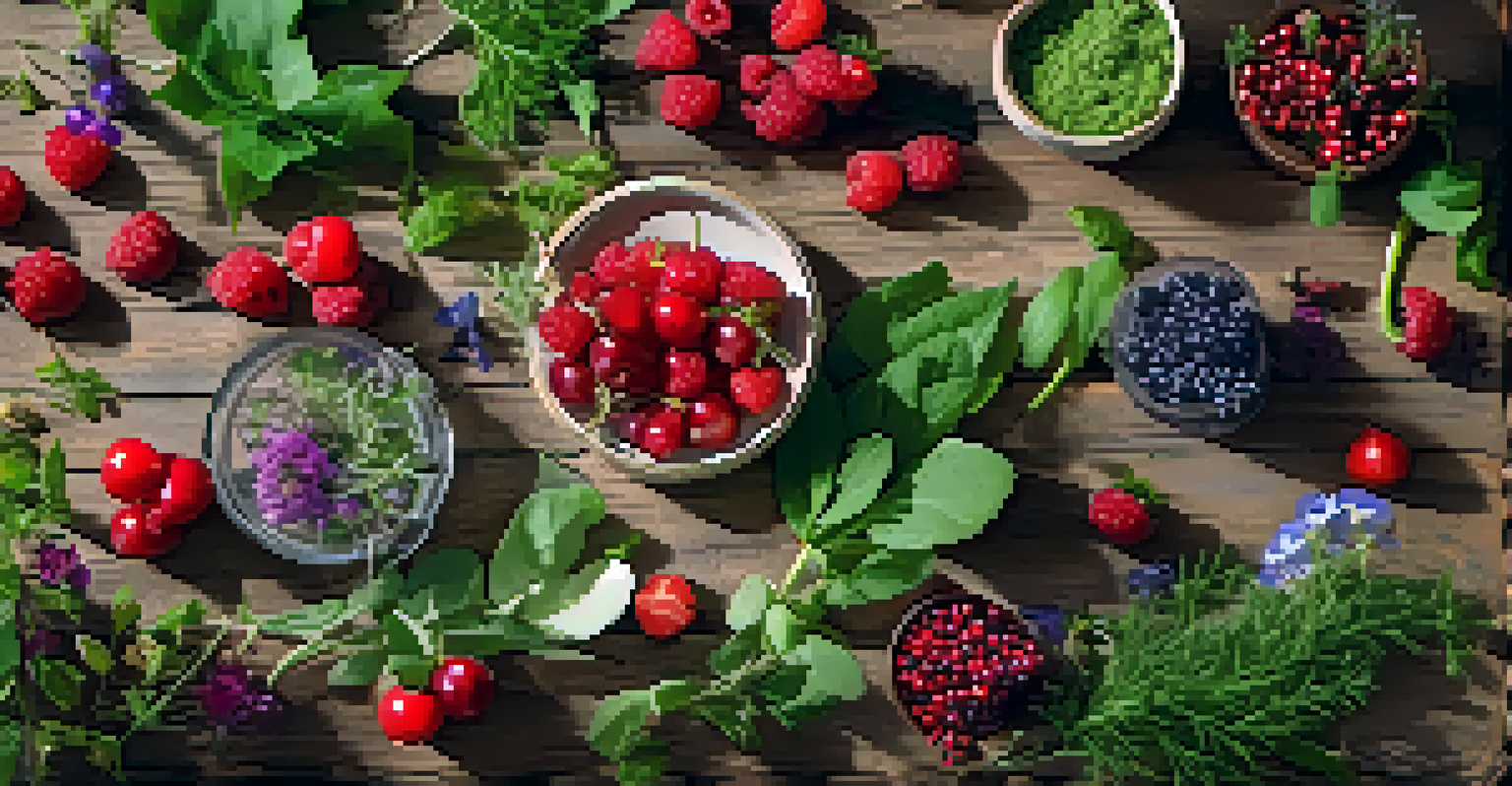Sustainable Practices in Harvesting Wild Edibles: A How-To

Understanding Wild Edibles and Their Importance
Wild edibles are plants that grow naturally in the wild, many of which are nutritious and flavorful. These plants not only enrich our diets but also contribute to biodiversity. By foraging for wild edibles, we connect with nature and embrace a more sustainable lifestyle.
The best time to plant a tree was twenty years ago. The second best time is now.
However, understanding the importance of these plants goes beyond personal consumption. They play crucial roles in their ecosystems, supporting wildlife and maintaining soil health. If we want to enjoy wild edibles sustainably, we must recognize their ecological significance.
This awareness sets the stage for responsible harvesting practices. By learning about the plants we harvest, we cultivate a sense of respect for nature and its delicate balance. This understanding is the first step toward a sustainable foraging journey.
Researching Local Edible Plants Before Harvesting
Before heading into the wild, it's vital to research local edible plants. Many regions have specific species that are not only safe to eat but also delicious. Utilizing local foraging guides or apps can help you identify what’s available in your area and when they are in season.

Additionally, understanding the growth patterns of these plants can inform your harvesting approach. Some plants are best harvested at certain times of the year, while others might need careful management to encourage growth. This knowledge ensures that your foraging efforts are both fruitful and sustainable.
Wild Edibles Support Ecosystems
Foraging for wild edibles enriches our diets while contributing to biodiversity and maintaining ecological balance.
Moreover, researching helps you differentiate between edible and toxic plants, which is crucial for your safety. By taking the time to learn, you equip yourself with the tools needed to forage responsibly and enjoy the bounty of nature without harm.
Choosing Sustainable Harvesting Techniques
Sustainable harvesting techniques are essential for protecting wild edible populations. One of the key practices is to never take more than you need; this is often referred to as the 'one-third rule.' By only harvesting a portion of a plant, you allow it to continue thriving and reproducing.
Nature does not hurry, yet everything is accomplished.
Another technique is to use proper tools and methods when gathering. For example, using scissors to snip herbs instead of pulling them out helps maintain the root system. This small change can have a significant impact on the plant's future growth.
Additionally, consider the surrounding environment when foraging. Avoid areas that are overharvested or distressed, and instead, focus on healthy patches that can sustain your harvest. These conscious choices help ensure that wild edibles remain abundant for future generations.
Identifying and Avoiding Overharvested Areas
Overharvesting can severely impact local ecosystems, making it crucial to identify and avoid these areas. Signs of overharvesting include sparse plant populations, damaged vegetation, and soil erosion. If you notice these signs, it's best to move on and find more sustainable locations.
Moreover, establishing a personal code of ethics while foraging can guide your choices. This might include avoiding popular spots that others frequent, allowing the ecosystem to recover. By being mindful of where you harvest, you contribute positively to the environment.
Research Before Foraging
Understanding local edible plants and their growth patterns is crucial for safe and sustainable harvesting.
Being aware of these factors not only preserves the plants but also enhances your foraging experience. You'll find joy in discovering untouched areas that might offer even better bounty while fostering a deeper connection to the land.
Seasonal Awareness and Timing for Harvesting
Timing is everything when it comes to harvesting wild edibles. Different plants have specific growing seasons, and knowing when to forage can optimize your experience. For instance, spring is prime time for tender greens, while late summer is great for berries.
Understanding seasonal patterns also allows you to harvest at peak flavor and nutritional value. For example, many roots are best harvested in fall or winter when the plant's energy is stored underground. This not only benefits your palate but also supports sustainable practices.
Moreover, seasonal awareness fosters a deeper appreciation for nature's cycles. As you observe these changes, you become more in tune with your environment, creating a more enriching foraging experience.
Practicing Ethical Foraging and Respect for Nature
Ethical foraging means respecting the land and its resources. This involves not just following sustainable harvesting practices but also honoring the ecosystems you engage with. Avoid trampling on sensitive areas and consider the wildlife that depends on those plants.
One way to practice ethical foraging is to educate yourself about the cultural significance of certain plants. Many indigenous cultures have deep-rooted traditions surrounding wild edibles, and understanding these can enhance your appreciation for what you’re gathering.
Practice Ethical Foraging
Respecting nature and following sustainable practices ensures the preservation of wild edibles for future generations.
Ultimately, ethical foraging is about cultivating a harmonious relationship with nature. By approaching your foraging adventures with respect and care, you contribute to the preservation of these valuable resources for future generations.
Preserving Your Harvests for Future Enjoyment
Once you've successfully foraged wild edibles, it's important to think about preservation. Many wild plants can be dried, pickled, or frozen, allowing you to enjoy their flavors long after the season has passed. This not only minimizes waste but also enhances your culinary experiences year-round.
For example, herbs like wild garlic can be dried and used for seasoning, while berries can be made into jams or jellies. These preservation techniques not only extend the shelf life of your harvest but also inspire creativity in the kitchen.

Moreover, preserving your foraged foods connects you back to the land. Each jar of jam or dried herb serves as a reminder of your adventures and the sustainable practices you embraced while gathering them. It’s a delightful way to celebrate your efforts and share the bounty with others.